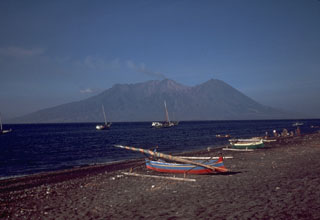Report on Sangeang Api (Indonesia) — August 1985
Scientific Event Alert Network Bulletin, vol. 10, no. 8 (August 1985)
Managing Editor: Lindsay McClelland.
Sangeang Api (Indonesia) Eruption declines; 4.5 km lava flow
Please cite this report as:
Global Volcanism Program, 1985. Report on Sangeang Api (Indonesia) (McClelland, L., ed.). Scientific Event Alert Network Bulletin, 10:8. Smithsonian Institution. https://doi.org/10.5479/si.GVP.SEAN198508-264050
Sangeang Api
Indonesia
8.2°S, 119.07°E; summit elev. 1912 m
All times are local (unless otherwise noted)
"Sangeang Api continued to erupt in early September. Activity consisted of a single lava flow that has moved approximately 4.5 km W from Doro Api. The frequency of explosions has declined steadily from ~150/day in early August to ~50/day in early September. The maximum explosion cloud height was ~1 km. From 9 to 14 August, the number of small (M < 1) shallow volcanic earthquakes ranged from 190-400/day. By 6-11 September the number of volcanic earthquakes had decreased to 12-40/day."
"A gas plume has been continuously emitted from the volcano since activity began on 30 July. In late August, the gas plume rose less than 0.5 km and was carried W by steady winds. The plume was translucent with a bluish gray to bluish white color. The larger explosions contributed dark gray clouds of fine tephra to the plume. Its SO2 content was in the range of 50-100 metric tons/hour when measured on 23 August."
"The evacuation of the approximately 1,250 inhabitants from Sangeang Island was completed in early August. Inhabitants are in the process of moving their homes to Sumbawa Island."
Geological Summary. Sangeang Api volcano, one of the most active in the Lesser Sunda Islands, forms a small 13-km-wide island off the NE coast of Sumbawa Island. Two large trachybasaltic-to-tranchyandesitic volcanic cones, Doro Api and Doro Mantoi, were constructed in the center and on the eastern rim, respectively, of an older, largely obscured caldera. Flank vents occur on the south side of Doro Mantoi and near the northern coast. Intermittent eruptions have been recorded since 1512, most of them during in the 20th century.
Information Contacts: J. Matahelumual and T. Casadevall, VSI.

